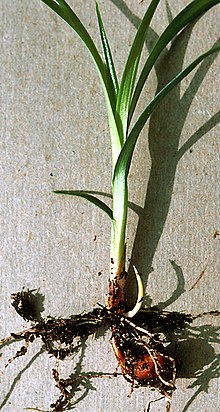| Cyperus esculentus | |
|---|---|
 | |
| Scientific classification | |
| Kingdom: | Plantae |
| (unranked): | Angiosperms |
| (unranked): | Monocots |
| (unranked): | Commelinids |
| Order: | Poales |
| Family: | Cyperaceae |
| Genus: | Cyperus |
| Species: | C. esculentus |
| Binomial name | |
| Cyperus esculentus L. | |
There are several varieties:
- Cyperus esculentus var. esculentus - Mediterranean region east to India
- Cyperus esculentus var. hermannii - Florida
- Cyperus esculentus var. leptostachyus - United States
- Cyperus esculentus var. macrostachyus - United States
- Cyperus esculentus var. sativus - Asia, cultivated origin
Contents
|
Cultivation and uses
History
Zohary and Hopf consider this tuber "ranks among the oldest cultivated plants in Ancient Egypt." Although noting "Chufa was no doubt an important food element in ancient Egypt during dynastic times, its cultivation in ancient times seems to have remained (totally or almost totally) an Egyptian specialty."[a] They were used to make cakes in ancient Egypt. Presently, they are cultivated mainly, at least for extended and common commercial purposes, in Spain, where they were introduced by Arabs, almost exclusively in the Valencia region. They are found extensively in California and were grown by the Paiute in Owens Valley.Tiger nuts are also grown in Ghana, Nigeria, Burkina Faso and Mali.
Use as food
The tubers are edible, with a slightly sweet, nutty flavour, compared to the more bitter-tasting tuber of the related Cyperus rotundus (purple nutsedge). They are quite hard, and are generally soaked in water before they can be eaten, thus making them much softer and giving them a better texture. They have various uses; in particular, they are used in Spain to make horchata. They are sometimes known by their Spanish name, chufa.Tigernuts have excellent nutritional qualities, with a fat composition similar to olives and a rich mineral content, especially phosphorus and potassium. The oil of the tuber was found to contain 18% saturated (palmitic acid and stearic acid) and 82% unsaturated (oleic acid and linoleic acid) fatty acids.[b]
According to the Consejo Regulador de Chufa de Valencia (Regulating Council for Valencia's Tigernuts),[c] the nutritional composition/100 ml of a classical horchata de chufas, or orxata de xufes in Valencian language, is as follows: energy content around 66 kcal, proteins around 0.5 g, carbohydrates over 10 g with starch at least 1.9 g, fats at least 2 g. It can be useful in replacing milk in the diet of people intolerant to lactose to a certain extent.


No comments:
Post a Comment